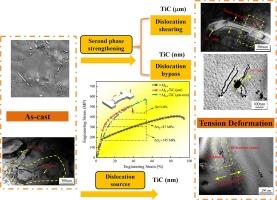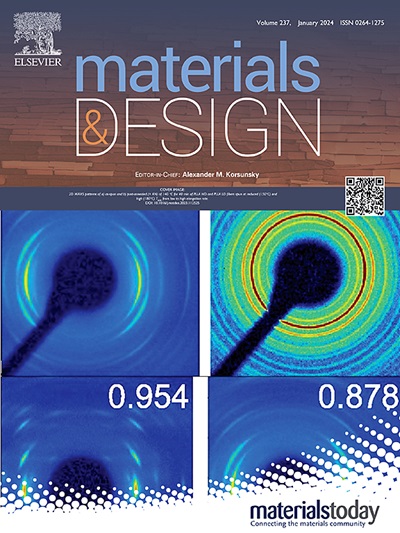Multi-scale ceramic TiC solves the strength-plasticity equilibrium problem of high entropy alloy
IF 7.6
2区 材料科学
Q1 MATERIALS SCIENCE, MULTIDISCIPLINARY
引用次数: 0
Abstract
High entropy alloys (HEAs) with single FCC structure exhibits unique structure and properties. However, lack of strength hinds the engineering application ability seriously. Therefore, it is urgent to propose effective methods and theories to enhance the strength while maintaining favorable plasticity. Introducing reinforced phases is one crucial research approach for improving the mechanical properties of HEAs. However, the resulting reduction in ductility has been neglected. In this work, we propose a novel multi-scale TiC coupling reinforced alloy which preserves the high plasticity while increasing the strength. The results demonstrate that TiC (μm) hinders the dislocations movement and improves strength through the second phase strengthening mechanism. Apart from acting as barriers to dislocation motion, the TiC (nm) also provides more dislocation sources in the distortion area at the junction with the matrix, which increasing the number of movable dislocations and enhancing the plastic strain capacity. Compared with the Al0.4 alloy, the tensile yield strength of the Al0.4-TiC (μm + nm) alloy is increased by 145 %, the ultimate tensile strength is up to 574 MPa, while maintaining a high plastic strain by 30.1 %. The addition of multi-scale ceramic phase TiC provides a novel approach to obtain high strength and high plasticity HEAs.

多尺度陶瓷 TiC 解决了高熵合金的强度-塑性平衡问题
具有单一 FCC 结构的高熵合金(HEAs)具有独特的结构和性能。然而,强度不足严重影响了其工程应用能力。因此,亟需提出有效的方法和理论,在提高强度的同时保持良好的塑性。引入增强相是改善 HEA 机械性能的一个重要研究方法。然而,由此导致的延展性降低却一直被忽视。在这项工作中,我们提出了一种新型多尺度 TiC 耦合增强合金,它在提高强度的同时保持了高塑性。研究结果表明,TiC(μm)可阻碍位错运动,并通过第二相强化机制提高强度。除了阻碍位错运动,TiC(nm)还在与基体交界的变形区域提供了更多的位错源,从而增加了可移动位错的数量,提高了塑性应变能力。与 Al0.4 合金相比,Al0.4-TiC(μm + nm)合金的拉伸屈服强度提高了 145%,极限拉伸强度高达 574 兆帕,同时保持了 30.1% 的高塑性应变。添加多尺度陶瓷相 TiC 为获得高强度和高塑性 HEA 提供了一种新方法。
本文章由计算机程序翻译,如有差异,请以英文原文为准。
求助全文
约1分钟内获得全文
求助全文
来源期刊

Materials & Design
Engineering-Mechanical Engineering
CiteScore
14.30
自引率
7.10%
发文量
1028
审稿时长
85 days
期刊介绍:
Materials and Design is a multi-disciplinary journal that publishes original research reports, review articles, and express communications. The journal focuses on studying the structure and properties of inorganic and organic materials, advancements in synthesis, processing, characterization, and testing, the design of materials and engineering systems, and their applications in technology. It aims to bring together various aspects of materials science, engineering, physics, and chemistry.
The journal explores themes ranging from materials to design and aims to reveal the connections between natural and artificial materials, as well as experiment and modeling. Manuscripts submitted to Materials and Design should contain elements of discovery and surprise, as they often contribute new insights into the architecture and function of matter.
 求助内容:
求助内容: 应助结果提醒方式:
应助结果提醒方式:


